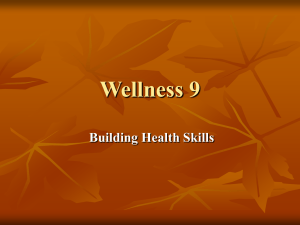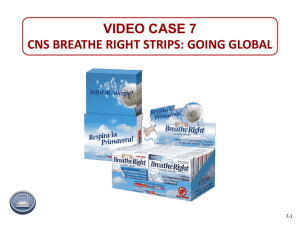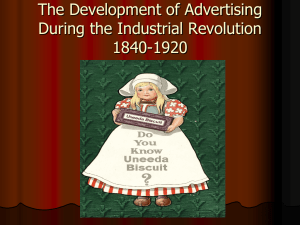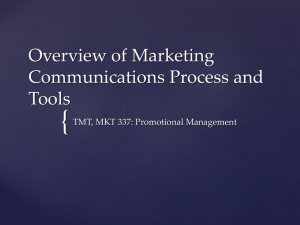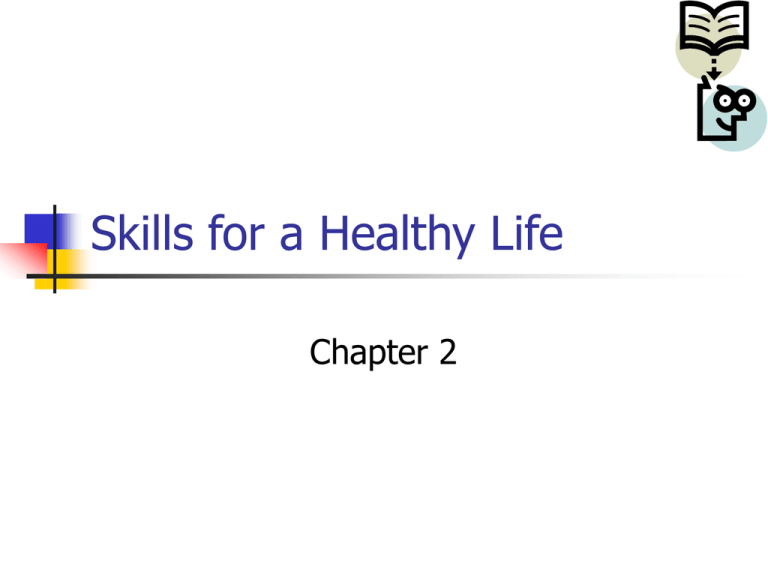
Skills for a Healthy Life
Chapter 2
What’s Your Health IQ?
1
2
3
4
=
=
=
=
Never
Sometimes
Most of the time
All of the time
What’s Your Health IQ?
1.
2.
3.
4.
I review all of my choices before I make a decision.
I think about the outcome for each possible choice.
I make decisions that support my beliefs.
I think about the decisions I make afterward so that I
can learn from them.
5. I stop to think about who might be affected by the
decisions I make.
6. I usually ask for advice when I have a tough decision to
make.
7. If I make a bad decision, I try to correct any problem my
decision caused.
Building Life Skills
Chapter 2.1
2.1 Objectives
State the importance of practicing life
skills for lifelong wellness.
List 10 life skills that you need for a
healthy life.
Predict how you can use each of the
10 life skills in your daily life.
2.1 Key Terms –
Cornell Note Taking Style (CNS)
What is a Life Skill?
A tool for building a healthy life
What is coping?
Dealing w/problems & troubles in
an effective way
What is a consumer?
A person who buys products or
services
2.1 Key Terms con’t.–
Cornell Note Taking Style (CNS)
What is the Media?
All public forms of
communication, ex:
TV, radio, Internet, Newspaper,
advertisements, billboards,
movies, bumper stickers
What is a Resource?
Something that you can use that
helps you achieve a goal
(CNS)
1.
2.
3.
What
are
the 10
Life
Skills?
4.
5.
6.
7.
8.
9.
10.
Communicating Effectively
Practicing Wellness
Coping
Being a Wise Consumer
Evaluating Media Messages
Assessing Your Health
Using Community Resources
Making GREAT Decisions
Using Refusal Skills
Setting Goals
1. Assessing Your Health
How do you know if you are doing the
right thing for your health?
This life skill will help you:
Evaluate your health
Evaluate how your actions & behaviors
affect your health
Enable you to find out what you need to do
to improve your health
2. Communicating Effectively
Knowing how to listen & speak
effectively
These skills will help improve your
relationships with your
family,
classmates,
teachers & other adults
3. Practicing Wellness
Examples of healthy behaviors you may
practice are:
getting enough sleep,
choosing nutritious foods, &
avoiding risky behaviors.
4. Coping
Dealing with troubles or problems in a
effective way.
This life skill will help you deal with:
difficult times & situations &
with emotions such as
anger,
depression, &
loss of a loved one.
5. Being a Wise Consumer
A consumer is a person who buys
products or services.
This life skill will help you make good
decisions when buying health products
& services.
6. Evaluating Media Messages
The average number of advertisements a
person sees in 1 day is 3,000
The media has a significant influence on what
you learn about the world.
This life skill will give you the tools to analyze
media messages.
Knowing how to analyze media messages will
help you make better decisions about your
health.
7. Using Community Resources
Every community has a wealth of
services that provide help for all aspects
of health (mental & physical)
This life skill will help you find these
services
8. Making GREAT Decisions
This life skill will give you the steps to
make the right decisions for yourself.
9. Refusal Skills
This life skill will provide you with
different ways you can say “no” to
something you do not want to do.
10. Setting Goals
This life skill will provide you with tips
to help you reach your goals.
Being a Wise Consumer
What is a
consumer?
Someone who buys &
uses products &
services
What Influences A
Consumer To Buy?
Your needs, wants and values
Family
Advertising
Society
Culture
Financial resources
Friends
Interests
Technology
Protect Your Privacy!
What is
Identity
Theft?
The illegal use of an
individual’s personal
information.
How
Does
Identity
Theft
Happen?
Your wallet or purse containing
personal info is stolen
Your mail is stolen
You complete a change of address
form to have your mail sent to
another location
Your information is taken out of the
dumpster
Someone looks over your shoulder
From your credit receipts
Off the internet
Your records at a business are stolen
People pose as reps from banks or
government agencies to get the
information directly from you
What can
you do to
protect
yourself?
Don’t give out your S.S. number
Don’t give out personal info over
the phone, mail, or e-mail
Use a secure site when giving info
out on the internet
Tear up or shred documents
Change online passwords
frequently
Keep personal information locked
up
Make sure no one is watching
when you use the ATM machine
Section Review
Chapter 2.1
2.1 Review – Key Terms
What is coping?
Identify the term for “a person who
buys products & services.
Identify the term for something that
you can use to help achieve a goal.
2.1 Review – Key Ideas
Summarize the importance of practicing life skills
for lifelong wellness.
Name the skill that teaches you good listening skills
Identify the skill that helps you make good
decisions when buying health products or services.
Name the life skill that will help you say no to
something you don’t want to do.
2.1 Review – Key Terms
What is coping?
Dealing with problems & troubles in an effective
way
Identify the term for “a person who buys products
& services.
Consumer
Identify the term for something that you can use
to help achieve a goal.
Resource
2.1 Review – Key Ideas
Summarize the importance of practicing life skills for
lifelong wellness.
Using life skills can help enhance your health throughout
your lifetime
Name the skill that teaches you good listening skills
Communicating Effectively
Identify the skill that helps you make good decisions when
buying health products or services.
Being a Wise Consumer
Name the life skill that will help you say no to something
you don’t want to do.
Refusal Skills
2.1 Critical Thinking &
Summary
Practicing Wellness
Choose three life skills.
In your Journal, describe how you
can apply each of these life skills in
your life.
Write 2-3 sentences summarizing
what you learned in this section.
Making GREAT Decisions
Chapter 2.2
2.2 Objectives
Describe the importance of making
decisions.
Summarize what you should do if you
make a wrong decision
Apply the Making GREAT Decisions
model to make a decision
2.3 Key Terms – Cornell Notes
What is a
consequence?
A result of your
actions & decisions
What is
collaboration?
To work together
w/one or more
people
Using the Making GREAT
Decision Model (Cornell NS)
G
R
E
A
T
Give thought to the problem
Review your choices
Evaluate the consequences of
each choice
Assess & choose the best
choice
Think it over after you’ve made
your decision
Stop, Think, & Go (CNS)
STOP
THINK
GO
Stop & admit you made a poor
decision & take responsibility
for what you’ve done
Think about who you can talk
with to discuss ways to correct
the situation
Go & do your best to correct
the situation.
Section Review
Chapter 2.2
2.2 Review - Key Terms
1. Identify the term for “a result of your
actions and decisions.”
2. Define the term collaborate.
2.2 Review - Key Ideas
3. Describe the importance of making decisions.
4. Identify the steps of the Making GREAT Decisions
model.
5. Summarize why it is important to think about
decisions you make afterward.
6. Describe what you can do if you make a wrong
decision.
2.2 Review - Key Terms
1. Identify the term for “a result of your actions and
decisions.”
Consequence
2. Define the term collaborate.
To work together w/one or more people
3. Describe the importance of making decisions.
Because the decisions you make affect your health
& the health of others
2.2 Review - Key Ideas
3. Describe the importance of making decisions.
Because the decisions you make affect your health
& the health of others
4. Identify the steps of the Making GREAT Decisions
model.
Give thought to the problem
Review your choice
Evaluate the consequences of each choice
Assess & choose the best choice
Think it over after you’ve made your choice
2.2 Review - Key Ideas
5. Summarize why it is important to think about
decisions you make afterward.
So you can learn from the experience & use
what you learned the next time you make a
decision.
6. Describe what you can do if you make a wrong
decision.
STOP & admit that you made a bad decision,
THINK about who you can talk w/about the
correcting the situation, then
GO & do your best to correct the situation.
2.2 Critical Thinking &
Summary
Apply the Making GREAT Decisions model to
a situation in which you need to make a
decision.
Describe a time when you worked effectively
with someone else to make a decision.
Write 2-3 sentences summarizing what you
learned in this section.
Resisting Pressure from Others
Chapter 2.3
2.3 OBJECTIVES
State who influences your behavior.
Identify three types of direct pressure.
Identify three types of indirect pressure
State an example of each of the 12 types
of refusal skills.
Apply one of the refusal skills to a
pressure in your life.
2.3 Key Terms – Cornell Notes
What is
peer pressure?
Believing you should
do something
because your
friends want you to.
What is direct
pressure?
When someone tries
to convince you to
do something you
normally wouldn’t do.
2.3 Key Terms (CNS)
What is indirect
pressure?
Doing something
because people you
admire are doing it.
What are
refusal skills?
Strategies to avoid
doing something you
don’t want to do.
(CNS)
Who &
What
Influences
You?
Friends
Family
Media &
Advertisements
movies, TV, & radio
books, magazines,
newspapers,
the Internet
Media & Advertisements
What is the
purpose of
advertising?
To make people
want to buy - what
the advertiser has
to sell!
What are
the
benefits of
advertising
to the
consumer?
Helpful to consumers
when it provides
information about
products & services
Makes it possible for
information &
entertainment to be
provided at little or no
cost to the public
What are the
drawbacks of
advertising?
The average person sees 3,000 ads
daily
People find them annoying,
especially during their favorite T.V.
show
It persuades people to spend
money they can’t afford on goods or
services they don’t really need
Some ads are misleading
Increases the prices that consumers
pay for goods & services
Adding up to 75% to the cost of the
product
What is the
Power of
Advertising?
Advertising Influences
the food you eat,
the clothes you buy,
the car you drive etc….
What
are
some
types of
Ads &
where
do you
see
them?
Numerous Forms of Media
(channels of communication)
Newspaper and magazine ads
Radio and television
Infomercials
Internet ads
Direct mail
Outdoor advertising
Cell phones, blimps, carry ads
Your clothes!
(company names? Logos?)
Positive Images Having Fun
Hidden Fears
What
Persuasive
Techniques
do
advertising
companies
use?
“Once you pop, you just can’t stop!”
Putdowns
It shows the advantage of the product.
Slogans & Jingles
“I used this product & look at me now!”
Demonstrations
“Everyone else is using it!”
Testimonials
If you don’t use it you’ll be dirty, ugly, etc.
Bandwagon
You’ll be happy, healthy, smart, good
looking, popular… if you use our product
Negative statements about a competitor’s
product
Before & After
Fat to skinny
Acne to no acne
More Advertising Tricks
Amazing NEW Product
Sex Appeal
Symbols
Health Appeal
Snob Appeal
Bribery
Look For Facts
How Can
You
Evaluate
Ads?
Check The Fine Print
Separate emotional appeals &
opinions from facts
Does the price change later
(credit cards and interest rates)
Analyze What Is Being Said
“Recliners for as little as $99”
Is that the lowest price recliner available
Watch Out For Vague Claims
“Doctors agree that…”
How many Doctors did they speak to?
It Is Illegal To Make False
Statements or Omit Information
What is
Deceptive
Advertising?
False Claims
Hidden Catches
“Free Gift”
Deceptive Pricing
“Reduces risk of skin cancer”.
“Sale- Jeans $34.99”, but they are always
that price
Bait & Switch
“We just sold the last one, but here is one
just like it (more expensive)”.
Analyze Your Ad!!
How is the advertiser trying to influence my
emotions?
What does the ad really say- underneath all
the distractions like music, celebrities, etc.?
Does the product itself really appeal to me,
or is it just the cleverness of the ad?
1.
2.
3.
1.
What information do I need in order to
decide whether this product is a good
choice for me?
4.
1.
2.
5.
What does one have to do with the other?
Does the ad provide that information?
If not, where could I get it?
What technique are they using?
Influences & Pressure (CNS)
What are
the Two
Types of
Influences?
Negative
Pressures you to do
something you
don’t want to do,
is morally wrong,
unlawful, or
physically harmful.
Positive
Pressures you to improve
yourself
(CNS)
What are
some
examples of
Negative
Influences?
Morally Wrong
Unlawful
racial or gender jokes
teasing
bullying
tagging
stealing
Physically Harmful
smoking
drinking alcohol
using drugs
(CNS)
What are
some
examples of
Positive
Influences?
Morally Right
Having friends or being a friend that is:
Lawful
Honest
Trustworthy
Respectful
Responsible
Having friends or being a friend that
supports the right to say “No” to doing
something unlawful
Physically Beneficial
Friends or being a friend who doesn’t let
friends do things that can hurt
themselves, like drinking & driving
(CNS)
What are the
Two Types of
Pressure?
Direct
Indirect
(CNS)
What are
some
examples
of Direct
Pressure?
Teasing
Persuasion
Explanations
Put-downs
Threats
Bribery
(CNS)
What are
some
examples
of Indirect
Pressure?
TV & Movies
Radio & Internet
Advertising
Role Models
Popular People
Famous People
1.
(CNS)
What
are the
12
Refusal
Skills?
2.
3.
4.
5.
6.
7.
8.
9.
10.
11.
12.
Blame Someone Else
Give a Reason
Ignore the Request or Pressure
Leave the Situation
Say “No thanks”
Say “No” & Mean It
Keep Saying “No”
Make a Joke Out of It
Make an Excuse
Suggest Something Else to Do
Change the Subject
Team Up With Someone
What You Can Say
Blame
Someone Else
“My dad would kill me if I didn’t
help him.”
Give a Reason
“No, my dad said he’d pay me $20
if I helped out.”
Ignore the
Request
Pretend that you don’t hear them
asking you.
Leave the Situation “I’m late. I’ve got to go.”
Say “No Thanks”
Say “No” & Mean It “No, I don’t want to!”
“No thanks. It’s not my style.”
Keep Saying “No”
“What part of no do you
not understand?”
Make a Joke
Out of it
“I’m already high on life.”
Make an Excuse
“It makes me sick.”
Suggest Something
Else to Do
“Let’s go shopping instead.”
Change the
Subject
“I heard Nick & Mary are
going together.”
Team Up With
Someone
“David, didn’t you say we
were going skating.”
(CNS)
Is it okay
to be
disrespectful
when you say
“No”?
Always respect others
Don’t insult or put anyone down
One reason people feel pressured is
that they don’t want to seem
disrespectful.
Disagreeing or saying no
does not mean people will
stop liking you.
If someone gets angry with you for
saying no, don’t feel as if you
should have said yes.
Your Values & Rights
Are Important (CNS)
Is the person
who won’t stop
pushing you, a
friend?
If it is, ask
yourself:
“Is this person really my
friend?”
“Would I be better-off not
hanging around with this
person?”
(CNS)
Why is it
important to
practice
Refusal
Skills?
It will help you cope with
difficult situations
The more you practice,
the better you’ll get at it
the more confident you will be
the better decisions you’ll make
the decisions you make will be
your own
The more confident you are,
the less people will pressure you.
If You Practice - You’ll Be
An Expert Before You
Know It!!!
Section Review
Chapter 2.3
2.3 Review
Define peer pressure.
What is a strategy used to avoid doing
something you don’t want to do called?
State five things that influence behavior.
Name the types of direct pressure.
Name the types of indirect pressure.
2.3 Review
Name the types of Direct Pressure
Name the types of Indirect Pressure
List the different ways you could say
“No” to someone who is pressuring you.
Describe why people feel pressured to
do things that they don’t want to do.
2.3 Review – True or False
Advertising is a form of Direct Pressure.
Saying No Repeatedly & using more
than one refusal skill may be necessary
for some types of pressures.
It’s okay to be disrespectful when
trying to refuse someone who is trying to
pressure you.
2.3 Review
Define peer pressure.
Feeling you should do something because
it’s what your friends want.
What is a strategy used to avoid doing
something you don’t want to do called?
Refusal Skill
State three things that influence behavior.
Family, Friends, Media
2.3 Review - Name The
Types of Direct Pressure
Teasing,
Persuasion,
Explanations,
Put-downs,
Threats,
Bribery
2.3 Review - Name The
Types of Indirect Pressure
TV, Movies,
Radio,
Internet,
Advertising,
Role Models,
Popular or Famous People
2.3 Review - List the ways you could say
“No” to someone who is pressuring you.
Blame Someone Else
Keep Saying “No”
Give a Reason
Make a Joke Out of It
Ignore the Request
Make an Excuse
Leave the Situation
Suggest Something Else to Do
Say “No Thanks”
Change the Subject
Say “No” & Mean It
Team Up With Someone
2.3 Review
Describe why people feel pressured to
do things that they don’t want to do.
They want to be accepted & not
make someone angry.
2.3 Review - True or False
Advertising is a form of Direct Pressure.
False, advertising is a form of Indirect
Pressure
Saying No Repeatedly & using more than
one refusal skill may be necessary for some
types of pressures.
True
It’s okay to be disrespectful when trying to
refuse someone who is trying to pressure you.
False, you should never be disrespectful to
anyone.
2.3 – Critical Thinking &
Summary
Use one of the Refusal Skills to deal
with a pressure you currently have in
your life.
Write 2-3 sentences summarizing what
you learned in this section.
Setting Healthy Goals
Chapter 2.4
2.4 Objectives
Differentiate between short-term &
long-term goals
Describe six suggestions for setting
goals
Develop an action plan to achieve a
personal goal
2.4 Key Terms (CNS)
Goal
achieve
something that you work
toward & hope to
Action Plan a set of directions that will
help you reach your goal
CNS
What are
the two
types of
Goals?
Short-term
Long-term
CNS
What are the
6 Suggestions
for Setting
Goals?
Safe -
Ask yourself, “Can this
goal harm me?”
Satisfying - You feel good about
yourself when you
reach the goal.
Sensible - Realistic & achievable
Similar Related to past goals
Specific Steps are clear
Supported - By responsible adults
CNS
What Are 3
Components
You Should
Include in an
Action Plan?
Rewards – set small rewards for
reaching small milestones toward
achieving your goal.
Influences – what influences will
help you or hurt your ability to
reach your goal
Tracking Your Progress –
review your progress weekly to
evaluate your progress & adjust
your plan as necessary
Section Review
Chapter 2.4
2.4 Review
What is the term for “something that work toward
& hope to achieve
Goal
Define “Action Plan”
A set of directions that will help you reach your
goal.
What is the difference between a short-term goal
& a long-term goal?
Short-term goals can be accomplished in days or
weeks
Long-term goals take months or years
2.4 Review
What are the 6 suggestions for setting goals &
what does each mean?
Safe
1st thing to ask yourself, “Can
Satisfying
Sensible
Similar
Specific
Supported
this goal harm me?”
You feel good about yourself
when you reach the goal.
Realistic for time & achievable
Related to past goals
Steps to achieve goal are clear
By parents or responsible adults
2.4 Review
What is the suggestion for setting goals
that recommends you avoid a goal that
hurts your health?
Safe – set goals that are safe
What is the suggestion for setting goals
the recommends that you choose a goal
that is realistic?
Sensible
2.4 Review
What are the 3 components you should to put
into your action plan?
Rewards – set small rewards for reaching small
milestones toward achieving your goal.
Influences – what influences will help you or
hurt your ability to reach your goal
Tracking Your Progress – review your
progress weekly to evaluate your progress &
adjust your plan as necessary
2.4 Review – Last Slide
What are the six risk factors that can keep
you from reaching your goal?
Drug & Alcohol Use
Sexual Activity
Behaviors That Cause Injury
Poor Dietary Patterns
Tobacco Use
Sedentary Lifestyle
Chapter Review
Chapter 2
Chap 2 – Review
Key Terms
All public forms of communication, such
as TV, radio, newspaper
Media
Something that you can use to help
achieve a goal
Resource
To work together w/one or more people
Collaborate or Collaboration
Chap 2 Review
Key Terms
A strategy to avoid doing something you
don’t want to do.
Refusal Skill
A person who buys products or services
Consumer
A feeling that you should do something
because your friends want you to.
Peer Pressure
Chap 2 Review
Key Terms
Dealing with problems & troubles in an
effective way.
Coping
A result of your actions & decisions
Consequence
A tool for building a healthy life
Life Skill
Chap 2 Review
Key Ideas
What is the life skill you would use to evaluate
how your actions affect your health?
Assessing Your Health
What is the life skill you would use to help you
say “No” to peer pressure?
Using Refusal Skills
Why is it important to evaluate the consequences
of each option before you make a decision?
Because this will help you reach a decision that
has the least negative consequences.
Chap 2 Review
Key Ideas
What does GREAT stand for?
G = Give Thought to the Problem
R = Review Your Choices
E = Evaluate the Consequences
A = Assess & Choose the Best Choice
T = Think it over Afterwards
Chap 2 Review
Key Ideas
What is the step in the Making GREAT
Decisions model in which you determine
whether you made the right decision?
Think It Over Afterward
What are the 3 steps to take if you made a
wrong decision?
Stop, Think, & Go
Chap 2 Review - Name the
Different Kinds of Direct Pressure
Teasing,
Persuasion,
Explanations,
Put-downs,
Threats,
Bribery
Chap 2 Review - Name the
Types of Indirect Pressure
TV, Movies,
Radio,
Internet,
Advertising,
Role Models,
Popular or Famous People
Chap 2 Review - What
Are The 12 Refusal Skills?
Blame Someone Else
Keep Saying “No”
Give a Reason
Make a Joke Out of It
Ignore the Request
Make an Excuse
Leave the Situation
Suggest Something Else to Do
Say “No Thanks”
Change the Subject
Say “No” & Mean It
Team Up With Someone
Chapter 2 Review
What is the Refusal Skill that requires
support from others?
Team up with someone
What is a goal?
Something that you work toward & hope to
achieve
What is an action plan?
A set of directions that will help you reach
your goal.
Chapter 2 Review
What is the difference between a shortterm goal & a long-term goal?
A short-term goal is one that can be
accomplished in a short amount of time,
usually days or weeks.
A long term goal takes months or years
to achieve.
Chap 2 Review
6 Suggestions for Setting Goals
Safe
Satisfying
Sensible
Similar
Specific
Supported
1st thing to ask yourself,
“Can this goal harm me?”
You feel good about yourself
when you reach the goal.
Realistic for time & achievable
Related to your values & past goals
Steps are clear
By parents or responsible adults
Chapter 2 Review
What are the 3 components you need to put
into your action plan?
Rewards – set small rewards for reaching
small milestones toward achieving your goal.
Influences – what influences will help you
or hurt your ability to reach your goal
Tracking Your Progress – review your
progress weekly to evaluate your progress &
adjust your plan as necessary
Chapter Review – Final Slide
What are the six common risk behaviors
among teens?
Drug & Alcohol Use
Sexual Activity
Behaviors That Cause Injury
Poor Dietary Patterns
Tobacco Use
Sedentary Lifestyle

